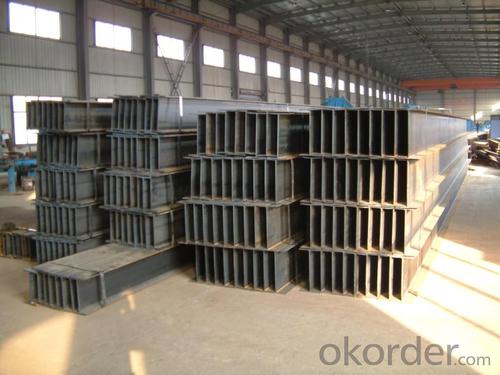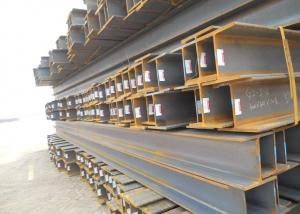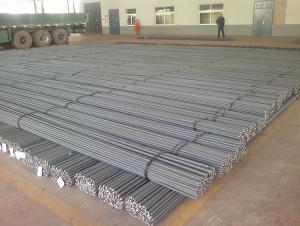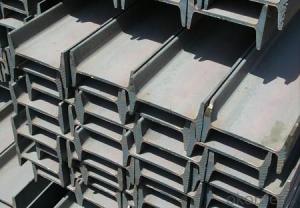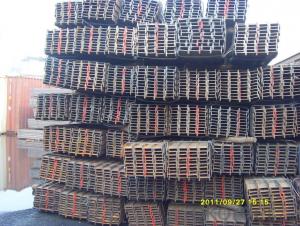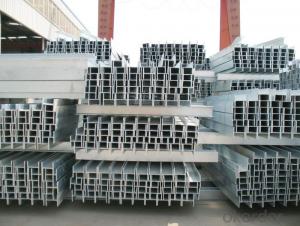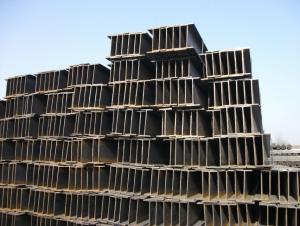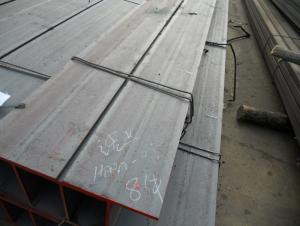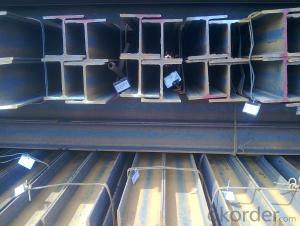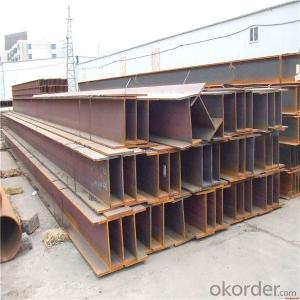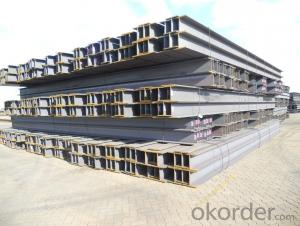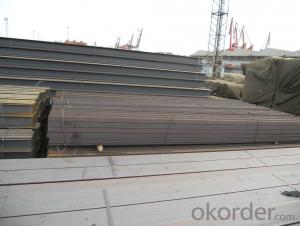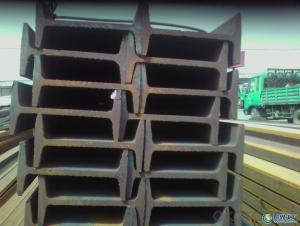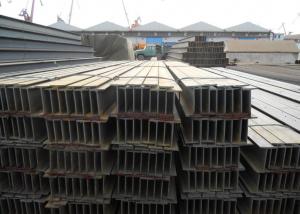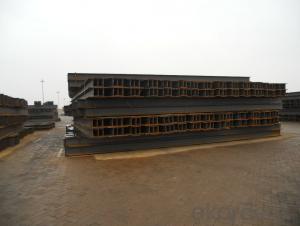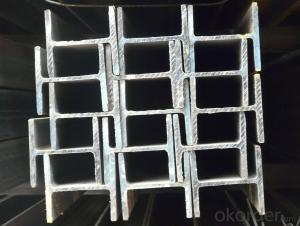GB Standard Steel H Beam 200mm-250mm with High Quality
- Loading Port:
- China main port
- Payment Terms:
- TT or LC
- Min Order Qty:
- 40 m.t
- Supply Capability:
- 15000 m.t/month
OKorder Service Pledge
OKorder Financial Service
You Might Also Like
Specifications of GB Standard Steel H Beam 200mm-250mm with High Quality For Sale:
1. Standard: GB Standard
2. Grade: Q235
3. Length: 12m
Size and Mass:
| Size (mm) | Mass (Kg/m) | Size (mm) | Mass (Kg/m) |
| 200*200*8.0 | 49.9 | 250*125*6.0 | 29.0 |
| 248*124*5.0 | 25.1 | 244*175*7.0 | 43.6 |
Usage & Applications of GB Standard Steel H Beam 200mm-250mm with High Quality For Sale:
Commercial building structure ;Pre-engineered buildings; Machinery support structure; Prefabricated structure; Medium scale bridges; Ship-building structure, etc.
Production flow of GB Standard Steel H Beam 200mm-250mm with High Quality For Sale:
Material prepare (billet) —heat up—rough rolling—precision rolling—cooling—packing—storage and transportation
FAQ:
Q1: Why buy Materials & Equipment from OKorder.com?
A1: All products offered byOKorder.com are carefully selected from China's most reliable manufacturing enterprises. Through its ISO certifications, OKorder.com adheres to the highest standards and a commitment to supply chain safety and customer satisfaction.
Q2: How do we guarantee the quality of our products?
A2: We have established an advanced quality management system which conducts strict quality tests at every step, from raw materials to the final product. At the same time, we provide extensive follow-up service assurances as required.
Q3: How soon can we receive the product after purchase?
A3: Within three days of placing an order, we will arrange production. The shipping date is dependent upon the quatity, how many sizes you want and the plan of production, but is typically 1 month to 2 month days from the beginning of production.
Images of GB Standard Steel H Beam 200mm-250mm with High Quality:
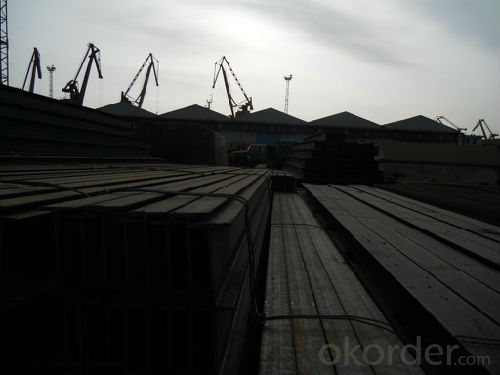
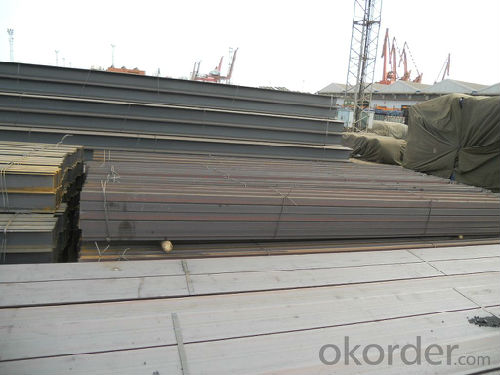
*If you would like to get our price, please inform us the size, standard/material and quantity. Thank you very much for your attention.
- Q: Can steel H-beams be used for theaters or auditoriums?
- Certainly! The utilization of steel H-beams in theaters or auditoriums is possible. Due to their robustness and ability to bear heavy loads, steel H-beams are frequently employed in construction. They offer structural reinforcement, making them well-suited for expansive areas such as theaters or auditoriums. Moreover, steel H-beams provide versatility in design, enabling the creation of airy and open layouts that are often sought after in these particular venues.
- Q: How are steel H-beams different from other types of beams?
- H-sections, also called Steel H-beams, possess distinct qualities and shape that set them apart from other beams. Their specific cross-sectional shape, resembling the letter "H," grants them significant advantages over alternative beam types. To begin with, the shape of the H-beam allows it to bear a greater load compared to beams of similar weight. This is due to the even weight distribution along its length, maximizing its ability to withstand heavy loads. Consequently, H-beams find extensive use in construction projects that demand robust and enduring structural support, such as high-rise buildings, bridges, and industrial facilities. Moreover, H-beams provide enhanced structural stability. The flanges, which are the top and bottom horizontal sections of the H-beam, offer resistance against bending and twisting forces. This characteristic makes H-beams less prone to deformations and enables them to maintain their shape under heavy loads. Additionally, the web, or vertical section of the H-beam, offers supplementary support and rigidity, ensuring overall stability in the structure. Another notable advantage of H-beams lies in their versatility. With their inherent strength and stability, H-beams can span longer distances without requiring intermediate supports. This enables the creation of larger open spaces and more flexible architectural designs. Furthermore, H-beams can be easily welded together, allowing for the creation of longer beams and expanding their range of applications. Lastly, H-beams offer cost-effectiveness. Despite their robustness, H-beams are comparatively lightweight in relation to their load-bearing capacity. This reduces transportation costs and simplifies the installation process, making them a cost-effective option for construction projects. In conclusion, Steel H-beams stand out from other beam types due to their unique cross-sectional shape. This shape provides advantages in terms of increased load-bearing capacity, structural stability, versatility, and cost-effectiveness. These characteristics make H-beams the preferred choice for various construction applications where strength, durability, and efficiency are crucial factors.
- Q: Are steel H-beams suitable for swimming pool structures?
- Yes, steel H-beams are suitable for swimming pool structures. They provide excellent strength and stability, making them a popular choice for supporting the weight of the pool and other associated structures. Additionally, steel H-beams are durable and resistant to corrosion, making them ideal for a moist and chlorinated pool environment.
- Q: Can steel H-beams be used for solar panel supports?
- Yes, steel H-beams can be used for solar panel supports. Steel H-beams provide excellent structural stability and strength, making them a suitable choice for supporting the weight of solar panels. Additionally, steel beams are durable and resistant to environmental factors, making them a reliable option for long-term support of solar panels.
- Q: Can steel H-beams be used in underground structures?
- Yes, steel H-beams can be used in underground structures. Steel H-beams are commonly used in construction for their strength and load-bearing capabilities. When used in underground structures, such as tunnels or underground buildings, H-beams provide structural support and stability. They can be used to create framework and support systems, ensuring the stability of the underground structure. Additionally, steel H-beams are resistant to corrosion, which is important in underground environments where moisture and other corrosive elements may be present. Overall, steel H-beams are a suitable choice for underground structures due to their strength, load-bearing capabilities, and corrosion resistance.
- Q: What are the different surface treatments available for steel H-beams?
- There are several surface treatments available for steel H-beams, including primer coating, galvanizing, and paint coatings. Primer coating provides a base layer that enhances corrosion resistance and adhesion of subsequent coatings. Galvanizing involves applying a zinc coating to protect against rust and corrosion. Paint coatings can be applied in various colors and finishes to provide aesthetic appeal and further protect the steel from environmental elements.
- Q: What are the different design considerations when using steel H-beams in architectural projects?
- When using steel H-beams in architectural projects, several design considerations need to be taken into account. These considerations include the following: 1. Structural Stability: Steel H-beams are primarily used for their load-bearing capabilities. Therefore, it is crucial to ensure that the design accounts for the structural stability of the beams. This includes analyzing the load distribution, deflection, and stress on the beams to ensure they can safely support the intended loads. 2. Span and Size: The span and size of the steel H-beams play a significant role in determining their load-bearing capacity. Depending on the architectural project's requirements, the appropriate beam size and span should be selected to ensure structural integrity and prevent any potential issues, such as excessive deflection or bending. 3. Connection Details: The connection details between steel H-beams and other structural elements are essential for creating a robust and reliable architectural design. Proper connection design ensures the transfer of loads efficiently, minimizes stress concentrations, and allows for ease of construction and maintenance. 4. Fire Resistance: Steel H-beams have good fire-resistant properties, but in certain architectural projects, additional fire protection measures may be required to meet local building codes and safety regulations. These could include fire-resistant coatings or fireproofing materials to enhance the overall fire resistance of the structure. 5. Aesthetics and Design Integration: While steel H-beams are primarily structural elements, they can also contribute to the overall aesthetics of an architectural project. Integrating the beams into the design in a visually pleasing way can enhance the project's appeal. This may involve considerations such as exposing the beams or integrating them into architectural features, such as creating an industrial or modern aesthetic. 6. Sustainability: In today's architectural projects, sustainability is a crucial consideration. Steel is a highly sustainable material as it is recyclable and can be reused. Therefore, when using steel H-beams, it is important to ensure that the design maximizes the use of sustainable materials and minimizes waste. 7. Cost Efficiency: Lastly, the cost efficiency of using steel H-beams should be considered. The cost of materials, fabrication, transportation, and installation should be weighed against the project's budget and design requirements. Proper planning and coordination with structural engineers and contractors can help optimize cost efficiency without compromising safety or quality. In conclusion, design considerations for using steel H-beams in architectural projects include structural stability, span and size, connection details, fire resistance, aesthetics and design integration, sustainability, and cost efficiency. By addressing these considerations, architects can ensure the successful integration of steel H-beams in their designs, creating safe, visually appealing, and sustainable structures.
- Q: What are the different corrosion protection methods for steel H-beams?
- There are several corrosion protection methods for steel H-beams, including galvanization, painting, epoxy coatings, and metalizing.
- Q: How do steel H-beams perform in terms of energy efficiency?
- Steel H-beams are not typically considered energy efficient on their own due to the significant amount of energy required in their production. This involves extracting iron ore, refining it into steel, and shaping it into H-beams, all of which consume a substantial amount of energy, mainly from fossil fuels. However, when assessing the energy efficiency of a building that incorporates steel H-beams, it is crucial to consider the overall lifecycle of the structure. Steel H-beams possess various advantages that contribute to energy efficiency in buildings. To begin with, steel is a durable and long-lasting material, resulting in structures built with steel H-beams having a longer lifespan compared to other construction materials. This longevity leads to energy savings over time as the building requires less frequent maintenance and replacement. Furthermore, steel H-beams offer exceptional structural strength and load-bearing capabilities, enabling the construction of larger open spaces with fewer supporting columns. This design maximizes natural lighting and ventilation, reducing the need for artificial lighting and mechanical ventilation and consequently reducing electricity consumption. Moreover, steel is highly recyclable, and a majority of the steel used in construction today is made from recycled materials. This recycling process significantly decreases energy consumption and greenhouse gas emissions associated with steel production. Additionally, at the end of a building's life, steel materials can be easily and efficiently recycled, further minimizing environmental impacts. In conclusion, while the production of steel H-beams requires a significant amount of energy, their use in construction can provide energy efficiency benefits. Their durability, load-bearing capacity, and recyclability contribute to the overall energy efficiency of buildings. However, it is crucial to consider the entire lifecycle of the structure and incorporate sustainable design principles to maximize energy efficiency.
- Q: How do steel H-beams contribute to the overall cost-effectiveness of a project?
- Steel H-beams contribute to the overall cost-effectiveness of a project in several ways. Firstly, they are an incredibly strong and durable material, which means that they require minimal maintenance and have a long lifespan. This reduces the need for frequent repairs or replacements, resulting in cost savings over time. Additionally, steel H-beams are lightweight compared to other construction materials, such as concrete or timber, making them easier and cheaper to transport and handle on-site. This can lead to reduced labor costs and shorter construction times, ultimately saving money in the overall project budget. Moreover, steel H-beams can be prefabricated off-site, which allows for greater precision and efficiency in the construction process. This reduces the risk of errors and wastage, leading to cost savings in terms of materials and labor. Furthermore, steel is a sustainable and environmentally friendly material. It is 100% recyclable, meaning that at the end of its lifespan, it can be repurposed or recycled, reducing waste and minimizing the environmental impact of the project. This aligns with the growing demand for sustainable construction practices and can potentially result in cost savings through incentives or tax benefits. Overall, the utilization of steel H-beams in a construction project offers numerous cost-effective advantages. Their strength, durability, and low maintenance requirements ensure long-term cost savings, while their lightweight nature and prefabrication capabilities reduce transportation and labor costs. Additionally, the sustainability of steel contributes to potential financial benefits.
Send your message to us
GB Standard Steel H Beam 200mm-250mm with High Quality
- Loading Port:
- China main port
- Payment Terms:
- TT or LC
- Min Order Qty:
- 40 m.t
- Supply Capability:
- 15000 m.t/month
OKorder Service Pledge
OKorder Financial Service
Similar products
Hot products
Hot Searches
Related keywords



